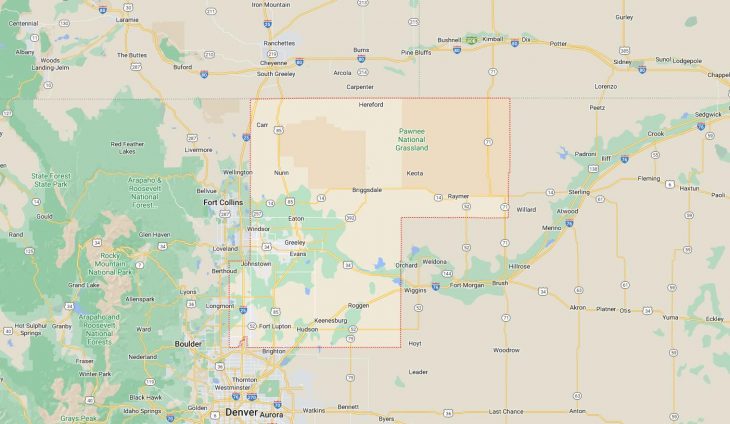Cities and Towns in Weld County, Colorado
Founded on 1861-11-01, Weld County is one of 64 counties in the state of Colorado. The city of Greeley is the county seat. With FIPS code of 123, Weld County has a population of 340,036 and area of 4,013.84 square miles (10,396 km²).
List of all cities in Weld County, CO alphabetically
| City/Town | Postal Code | Area Code |
| Ault, CO | 80610 | 970 |
| Briggsdale, CO | 80611 | 970 |
| Brighton, CO | 80603 | 303/720 |
| Carr, CO | 80612 | 970 |
| Dacono, CO | 80514 | 303/720 |
| Eastman Kodak Co, CO | 80551 | 970 |
| Eaton, CO | 80615 | 970 |
| Erie, CO | 80514 | 303/720 |
| Evans, CO | 80620 | 970 |
| 80634 | 970 | |
| 80645 | 970 | |
| Firestone, CO | 80504 | 303/720 |
| 80520 | 303/720 | |
| Fort Lupton, CO | 80621 | 303/720 |
| Fort Morgan, CO | 80742 | 970 |
| Frederick, CO | 80504 | 303/720 |
| 80530 | 303/720 | |
| Galeton, CO | 80622 | 970 |
| Garden City, CO | 80631 | 970 |
| Gilcrest, CO | 80623 | 970 |
| Gill, CO | 80624 | 970 |
| Greeley, CO | 80631 | 970 |
| 80632 | 970 | |
| 80633 | 970 | |
| 80634 | 970 | |
| 80638 | 970 | |
| 80639 | 970 | |
| Grover, CO | 80729 | 970 |
| Hereford, CO | 80732 | 303/720 |
| Hudson, CO | 80642 | 303/720 |
| Johnstown, CO | 80534 | 970 |
| Keenesburg, CO | 80643 | 303/720 |
| Kersey, CO | 80644 | 970 |
| La Salle, CO | 80645 | 970 |
| Lochbuie, CO | 80603 | 303/720 |
| Longmont, CO | 80504 | 303/720 |
| Loveland, CO | 80534 | 970 |
| Lucerne, CO | 80646 | 970 |
| Mead, CO | 80542 | 970 |
| Milliken, CO | 80543 | 970 |
| New Raymer, CO | 80742 | 970 |
| Niwot, CO | 80504 | 303/720 |
| Nunn, CO | 80648 | 970 |
| Pierce, CO | 80650 | 970 |
| Platteville, CO | 80651 | 970 |
| Raymer, CO | 80742 | 970 |
| Roggen, CO | 80652 | 303/720 |
| Severance, CO | 80546 | 970 |
| State Farm Ins, CO | 80638 | 970 |
| Stoneham, CO | 80754 | 970 |
| University of Northern Colorado, CO | 80639 | 970 |
| Wattenburg, CO | 80621 | 303/720 |
| Windsor, CO | 80550 | 970 |
| Windsor, CO | 80551 | 970 |














































